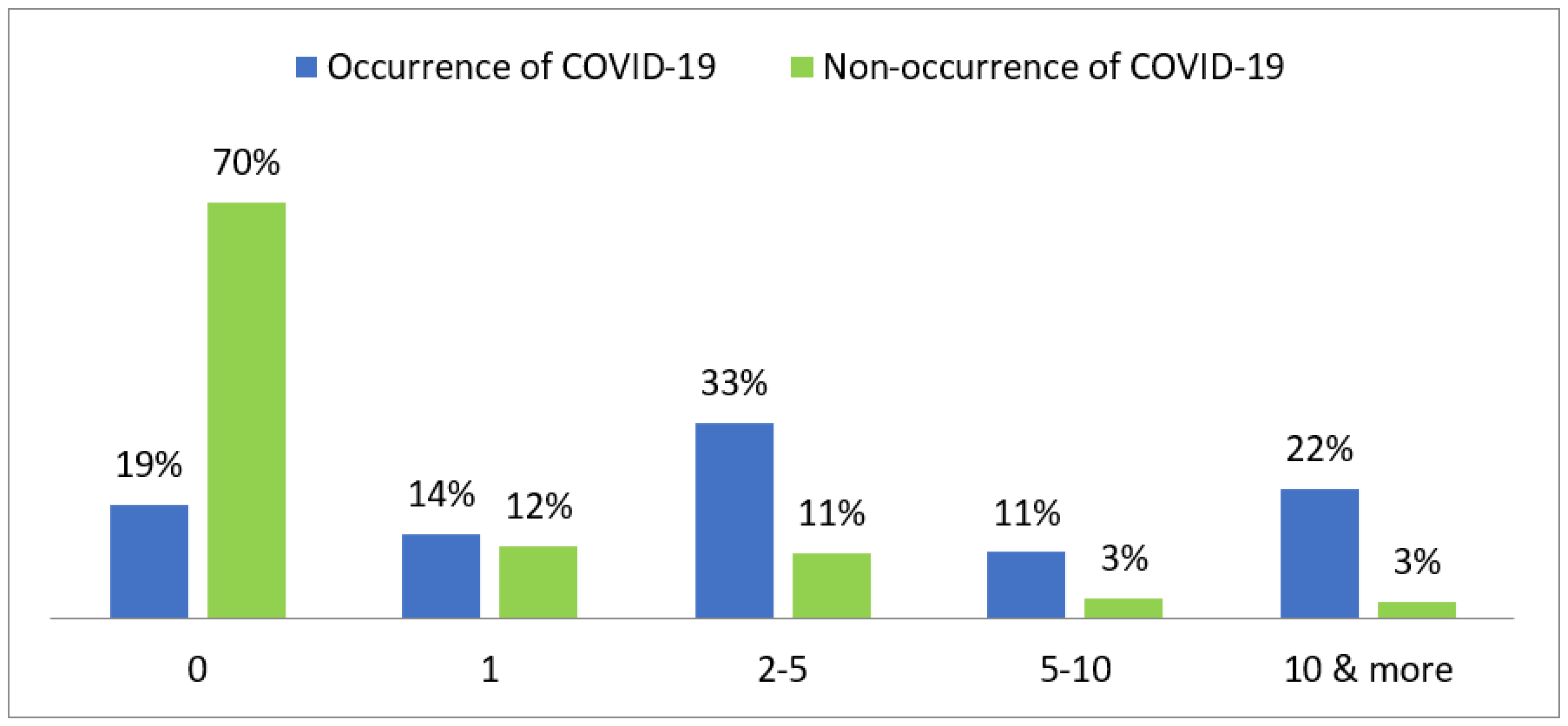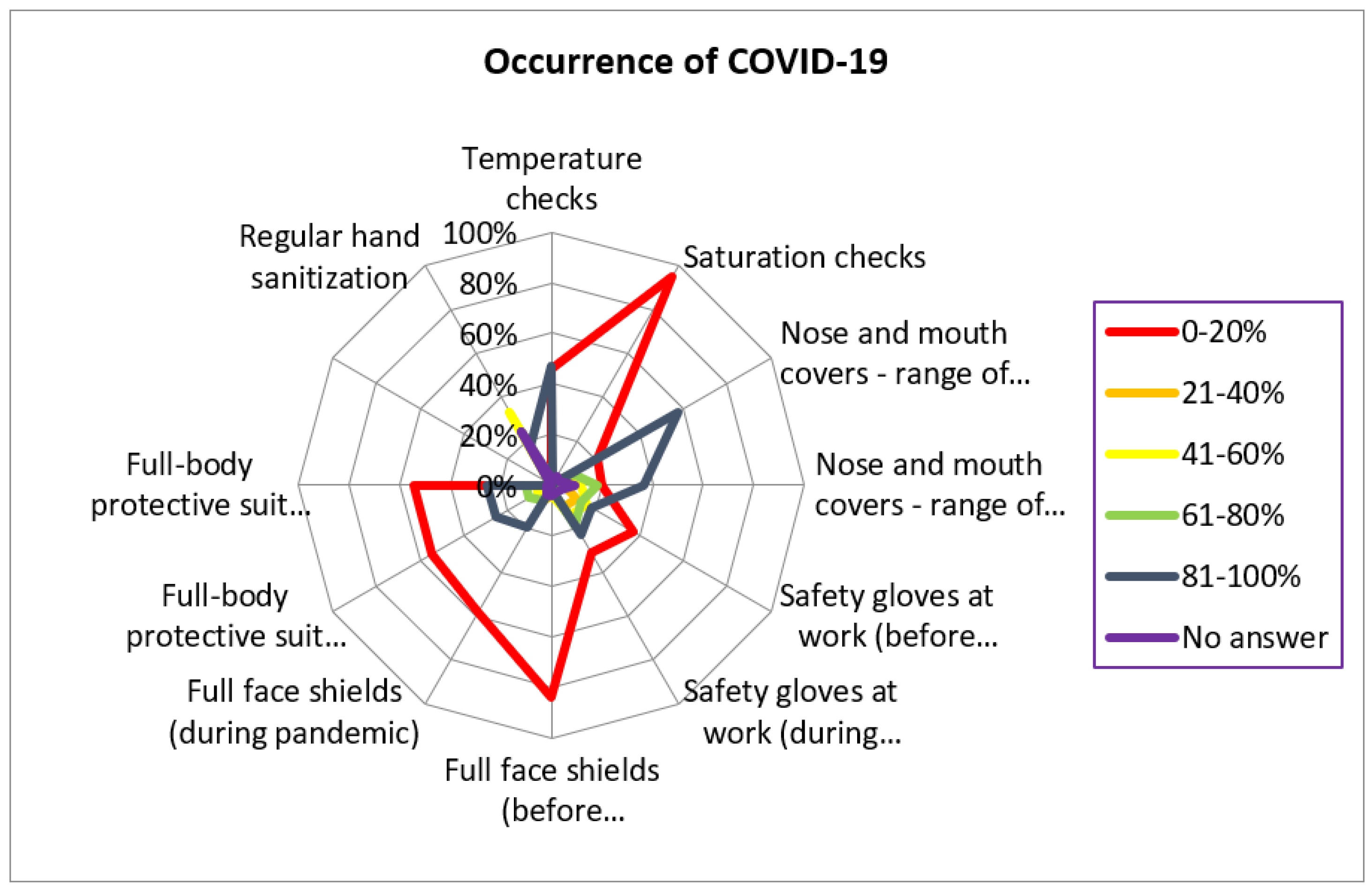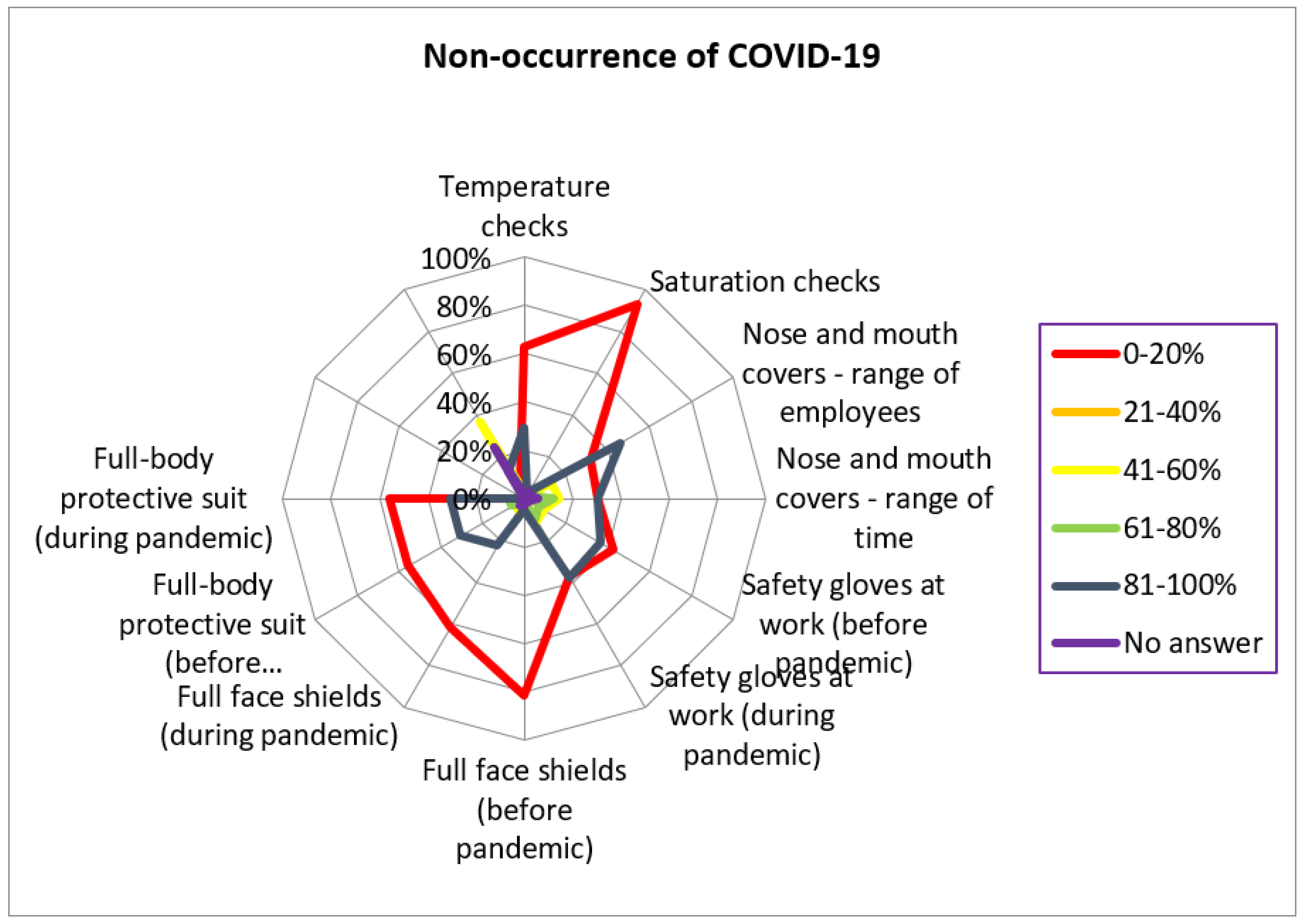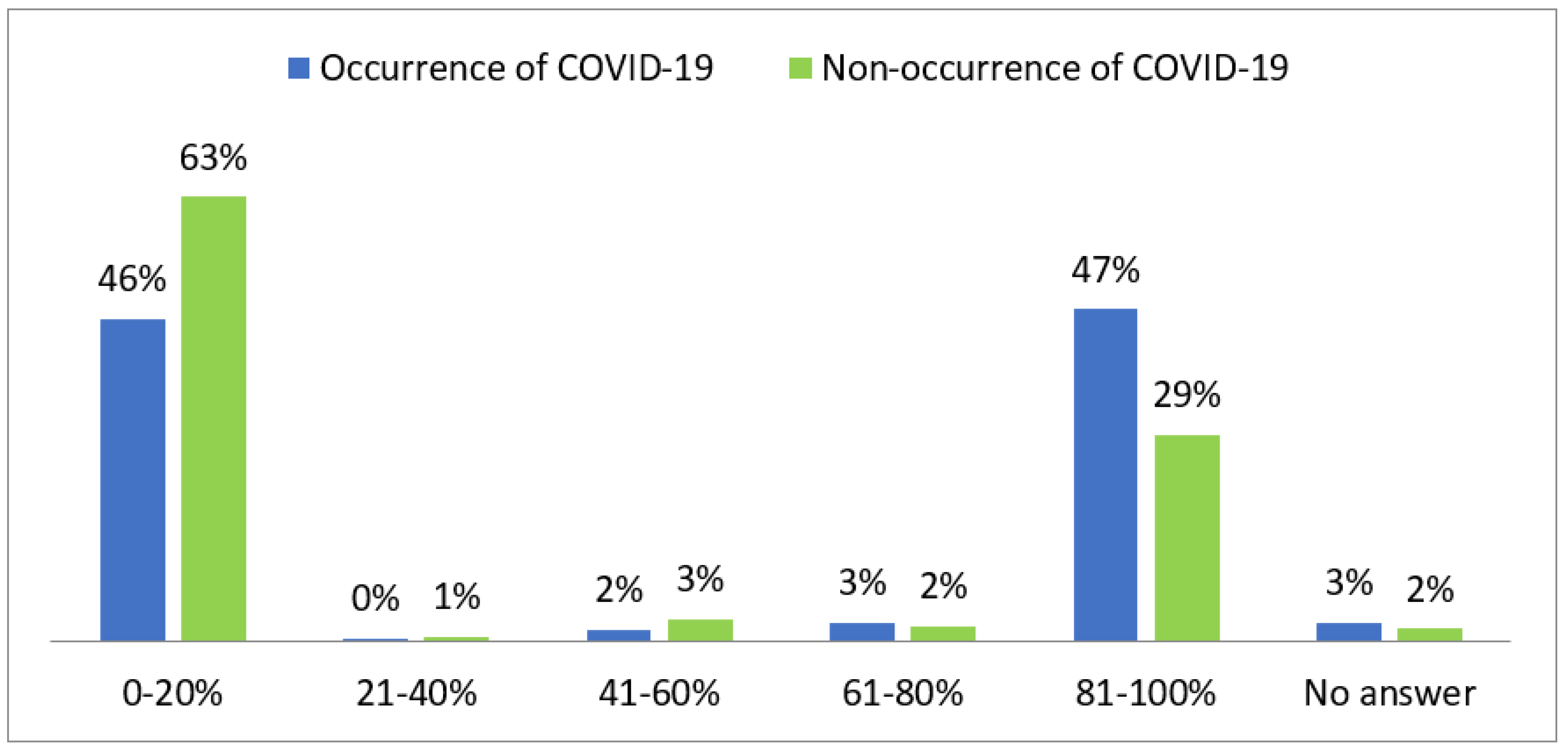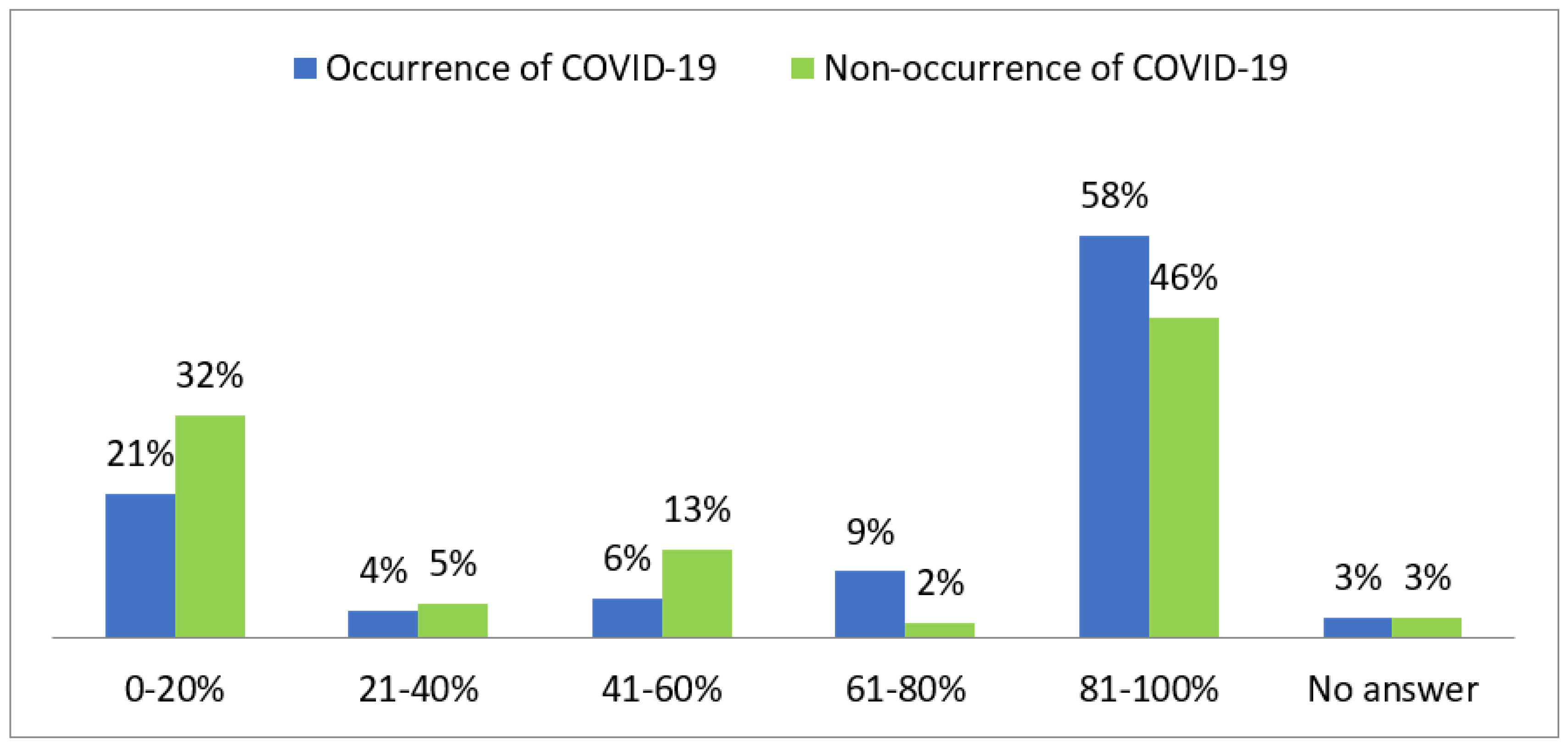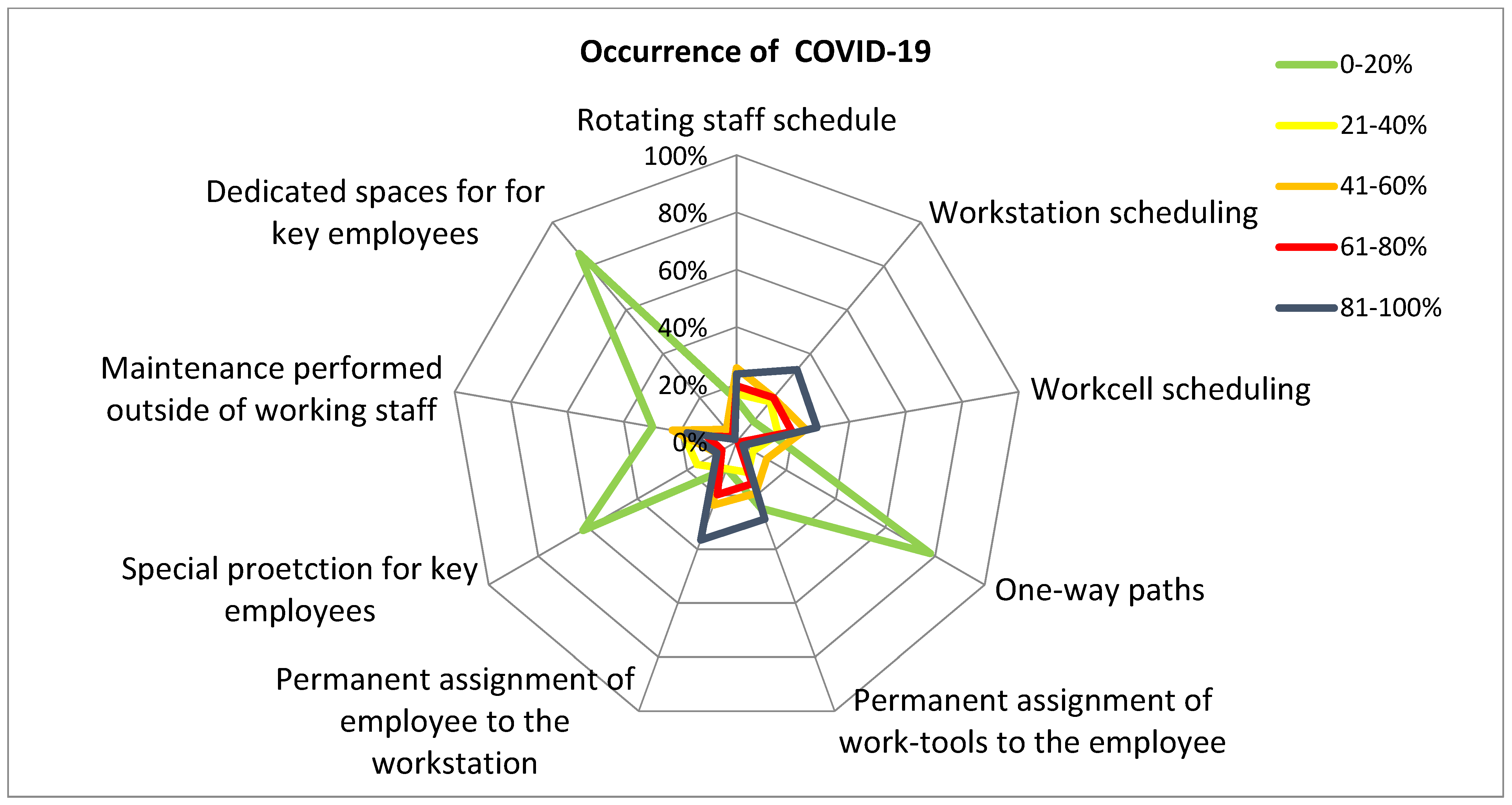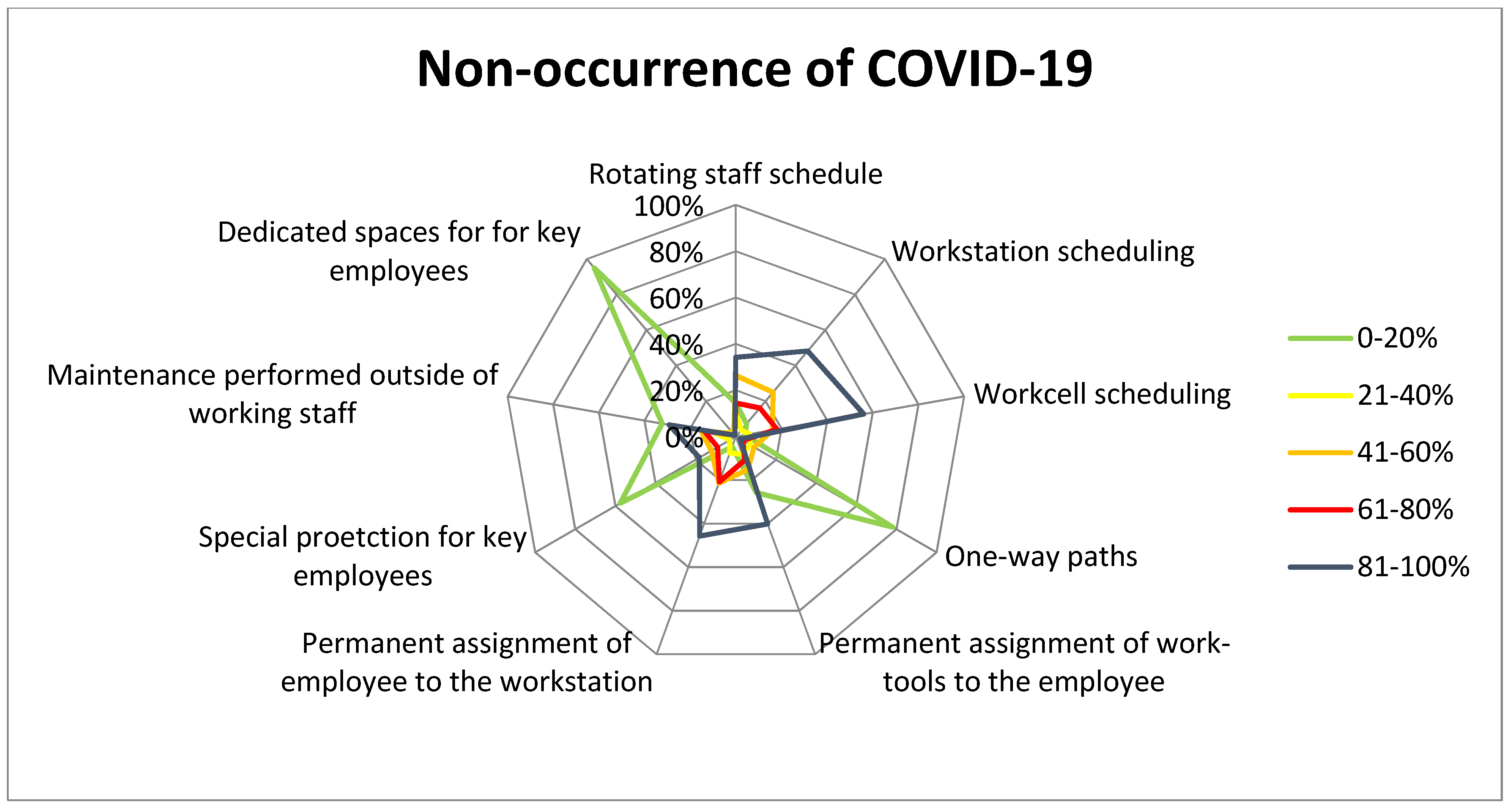1. Introduction
The COVID-19 pandemic, announced by the WHO on March 11, 2020, has significantly changed the functioning of societies in the sphere of private and professional life. On the one hand, it had a tremendous impact on the decline in the productivity of the world economy. On the other hand, it proved to be an impetus for the search for innovative solutions to enable the functioning of various organizations in the economic and social sphere in conditions of the sanitary regime and limited mobility.
Korneta and Rostek [
1] presented findings on the impact of the SARS-CoV-19 pandemic on the economies of 176 countries and showed a significant effect of the pandemic on the decline in the GDP of these countries. At the same time, it was noted that countries’ economies are developing resilience to the adverse effects of COVID-19, which is due both to actions taken by governments and to the operability of businesses and societies.
The results of research conducted in March 2021 for the European Parliament’s Committee on Industry, Research and Energy ITRE report [
2] indicate that there are significant differences between the impact of the pandemic on different sectors of the economy within the European Union. A rapid decline followed by slow growth in revenues is observed in industries such as chemicals, food and drinks, pharmaceuticals, and construction. Among the sectors best able to cope with the impact of the COVID-19 pandemic are digital and health care.
During the initial period of the pandemic, international organizations, e.g., World Health Organization [
3], the European Agency for Safety and Health at Work [
4], and International Labour Organization, as well as national ones, e.g., in the USA, International Facility Management Association, and in Poland, Ministry of State Assets, Ministry of Climate, and the Government Security Centre [
5], published general recommendations on how to stay safe in the workplace (
Table 1). These guidelines, at different stages of the pandemic, may have changed. However, the table shows recommendations assuming the highest (most restrictive) constraints.
Two approaches are identified in papers examining a pandemic’s impact on the operations of business entities: strategic and operational. Strategically, it is recommended to use approaches and methods specific to risk management to maintain the continuity of operations of manufacturing companies under pandemic conditions. The paper [
8] demonstrates how the application of standard risk management methodologies can help to better understand the risks associated with personal operations. It also shows how to ensure that the measures used to manage these risks are appropriate and effective. The paper [
9] proposes a systematic approach focused on building operational resilience. These two approaches take time and can therefore help prepare an organization for future crisis events.
The global pandemic has brought many challenges to corporate governance, requiring rapid adaptation of production strategies and a rethinking of product and material flows to meet staff protection requirements. The actions of the leaders have changed radically, by amplifying the implementation of appropriate measures to ensure care for the other members of the organization and all members of society [
10].
A study [
11] identified both positive and negative impacts of the COVID-19 pandemic on businesses. The elements more positively affected by COVID-19 were organizational systems, management, and strategy. At the same time, more than 50% of the corporations responded that operations and production were negatively affected.
The pandemic has resulted in the use of several innovative solutions based on remote human contact in operations, applicable in areas such as education [
12,
13], office work [
14], and partly in health services [
15]. These solutions are also likely to be used in the post-pandemic era, mainly where they result in efficiency gains. These solutions are also already used in manufacturing companies. The degree of use is limited because the core of their business is the physical flow of materials and products in the production process.
In terms of operational activities concerning the functioning of manufacturing companies under pandemic conditions, the authors identify two leading trends that will guide changes in production and operations management. The first is supply chain management changes, which will redefine supply chains and is focused on a gradual shift away from global suppliers to locally based ones. This gives the company more flexibility in managing ordered materials, parts, and components [
16,
17].
The second line of research concerns the possible scope of application of Industry 4.0 technologies, such as robots, cyber-physical systems, artificial intelligence, 3D printing, digital manufacturing, blockchain, etc., for the production of goods [
18]. Research presented by [
19] confirms that many companies have recently implemented or intend to implement robots and robotic systems to overcome the challenges of the pandemic. The study [
20] shows that almost 60% of the respondents indicated that robotization tools allowed for maintaining the continuity of business processes during the pandemic.
The reports of consulting companies primarily present the effects of the pandemic on the functioning of enterprises and identify solutions to support entrepreneurs during the pandemic. Findings on the impact of the pandemic on businesses in Poland can be found in reports by [
21,
22].
From the literature studies, it is evident that the COVID-19 pandemic is affecting all industries, which include manufacturing companies. There have also been different approaches in the literature to deal with the effects of the pandemic using various measures. However, from the point of view of state security, it is crucial to first take care of companies that belong to the critical infrastructure because it is on them that the level of state security will depend. Within the framework of the presented paper, the authors focused mainly on examining the possibility of increasing the level of security and ensuring business continuity of manufacturing companies, for example, the food product or pharmaceutical industries.
The authors did not identify papers with comprehensive research findings on recommended and applied measures for manufacturing enterprises during the COVID-19 pandemic beyond the commonly recommended measures involving personal protective equipment and social distance, so they decided to conduct their research. Piece-wise results for the implementation of robotization as a protective measure in service enterprises are included in the paper [
20]. Given the identified gap, the described study focuses on the solutions implemented in manufacturing enterprises during the COVID-19 pandemic to explore both the extent of application of measures recommended by international and governmental organizations, as well as measures involving modifications to the organization of workplaces and production processes recommended by experts in the field of post-production management. This paper aims to show the differences between the extent of implementation of particular measures in enterprises that have struggled with the effects of COVID-19 cases found in employees and those that have not. The analysis is mainly aimed at drawing qualitative conclusions. It is expected to answer whether particular measures were applied and, if so, to what extent and what relation do they have to the occurrence of COVID-19 cases in enterprises. The identified measures can provide a basis for responding to similar crisis incidents in the future and be good practices to implement in other organizations. The accumulated research material is much broader and will be provided in subsequent publications. An in-depth statistical analysis will be conducted, including correlation tests,
t-tests, etc.
The paper is structured as follows.
Section 2 presents the methodology of the work, the research questions, and information on how the survey was conducted and how the data were analyzed.
Section 3 presents a discussion of the research findings, and
Section 4 provides an analysis and discussion.
Section 5 summarizes the results scientifically and practically.
2. Materials and Methods
The paper presents the survey results of a representative group of 600 Polish manufacturing companies. The enterprises were selected in a stratified random way. In the first stage, the layers were identified as divisions of the Polish Classification of Activities of enterprises for the section “Industry”. Then, in a given stratum, there was a random selection of entities participating in the survey. The identified enterprises participated in a mix-model Computer Assisted Telephone Interview/Computer Assisted Web Interview (CATI/CAWI) survey. The survey was conducted between February 5, 2021 and March 5, 2021.
The subject of the study was to identify and assess the extent of the use of measures put in place in manufacturing companies during the COVID-19 pandemic.
The measures were classified into five groups:
Legal and regulatory measures (6 measures).
Personal protective measures (7 measures).
Protective measures for groups of workers (8 measures).
Work organization measures (9 measures).
Measures of production organization (12 measures).
Due to the limited time that companies have been operating under pandemic conditions, there is a lack of papers on systematic studies of measures used in manufacturing companies to limit the transmission of the SARS-CoV-19 virus. The authors of the paper [
23] surveyed 50 leading global companies from secondary sources and identified actions taken about business continuity under COVID-19 conditions. They proposed a classification of these actions into five areas and related sub-areas:
Operation and Value System (Supply Chain Status, Logistic Flow In/Out, Manufacturing Processes).
Customer Experience and Support (Physical Interactions, Financial Assistance, Marketing Communication).
Workforce and Human Capital (Prevention Measures, Job Continuity/Productivity, Handling of Cases).
Leadership and Change Management (Crisis Management, Post-Emergency Value).
Community and Social Engagement (Donations and Support, Coordinated Actions).
In the paper [
23], the authors discussed different business disruptions caused by COVID-19 and they developed an integrated policy framework in which they proposed specific strategic responses for increasing the level of organizational resilience: Financial Support, Sanitary Norms, Business Models/Business Systems, Digital Investment, Support to Education.
While both of the above approaches define general groups of measures, this survey focuses on specific measures applied in the operational activities of companies. The three groups of measures selected for this survey (1, 2, 3) appeared to largely coincide with the measures proposed by [
24] in group 3 (Workforce and Human Capital/Prevention Measures). This survey, in
Section 4 and
Section 5, contains a detailed development of the measure “Update or reengineer production to enhance workforce security” classified in group 1 (Operations and Value System/Manufacturing Processes).
Closed questions were formulated within each group, and an additional open-ended question "What other measures are in place?" was used to collect additional information from respondents. The survey included measures identified through a research procedure involving four steps:
Literature research.
Recommendations presented in international and national guidelines (
Table 1).
Information obtained from manufacturing companies (interviews conducted in manufacturing companies with production managers, middle-level management, production employees, and safety representatives).
Expertise of the study authors (in production management, risk management, and business continuity).
The survey identified total of 42 measures in five groups. Some measures were indicated in the literature and the recommendations of international and national organizations. Some others were selected based on the knowledge and experience of production staff and the many years (more than a decade) of cooperation of the study authors with production enterprises. The measures identified are presented in
Table 2. The extent of implementation of solutions introduced in manufacturing companies to ensure business continuity under the conditions of the COVID-19 pandemic is shown in the paper [
25].
Of the 600 manufacturing enterprises surveyed, 590 responded to whether COVID-19 occurrence had been identified in the enterprise. Only these companies were included in this study. Of the 590 companies, 306 declared that they had identified the occurrence of COVID-19 among their employees, while 284 did not. These values allow us to assume that both groups were balanced and it is possible to conduct comparative analyses of the results obtained.
The research approach developed by the authors included several successive steps. The study was preceded by a thorough analysis of the literature. It was determined what measures were recommended by international organizations and institutions, and other researchers. Before the study, the research team tentatively identified measures that could/should be applied in companies to reduce the impact of the pandemic. It was also decided to collect information on other measures used at the initiative of companies. The pandemic management solutions of the surveyed companies were then collected and sorted according to the presence or absence of COVID-19 cases. The research aimed to determine what measures were used and to what extent in enterprises in the context of the COVID-19 occurrence. Answers were obtained as to whether the solution was implemented in a particular production area and whether the solution was used to a limited or large extent. The extent of solution implementation was measured using the maturity scale below:
Level 1: 0–20% of workstations/operations have a given measure implemented,
Level 2: 21–40% of workstations/operations have a given measure implemented,
Level 3: 41–60% of workstations/operations have a given measure implemented,
Level 4: 61–80% of workstations/operations have a given measure implemented,
Level 5: 81–100% of workstations/operations have a given measure implemented.
The survey authors wanted to determine whether a given security measure is implemented in a structured manner in the enterprise and is used by all employees or only selected individuals. It is crucial to obtain a breakdown of these responses. The effectiveness of a measure (e.g., mouth and nose covers) depends on whether it is used by, for example, 10% of employees or more than 80% of employees. The results made it possible to analyze the reasons for using specific solutions and their impact on the COVID-19 occurrence. The indications of respondents make it possible to determine which of the identified measures should be proposed for implementation in manufacturing enterprises in the event of a similar emergency in the future. Manufacturing companies cannot move their operations to remote work. The vast majority of activities must be undertaken within the production system, in a given production area, using infrastructure in the form of machinery, tooling, and employees. The results can help these enterprises maintain business continuity in a crisis.
The following research questions were addressed:
Research question 1: Are there similarities and differences in implementing measures against COVID-19 in enterprises with SARS-CoV-2 virus infection and those without an identified case?
Research question 2: Is the extent of security measures (level of implementation per job/operation) higher in companies with or without an identified case of COVID-19?
Research question 3: Is it possible to implement other protective measures against COVID-19 in manufacturing enterprises?
The studies aimed to answer research questions were conducted in the following cross-sections:
The share of use of a given measure among the companies with or without an identified case of COVID-19 in the company.
The extent of use of given measure and the extent of use of a given measure as calculated by the percentage of jobs/operations where the measure was implemented.
The systematics of additional measures identified by survey respondents.
The STATISTICA package of TIBCO Software Inc. version 13.3.721.0 and MS Excel were used for data analysis.
3. Results
The main objective of the study was to determine differences in the behaviors of enterprises with identified cases of COVID-19 virus infection compared to those without. The study has the advantage of being able to analyze the results obtained in the first year of the COVID-19 pandemic. During this period, the infectivity of the SARS-CoV-2 virus was at a lower level than from 2021–2022. This allows comparing of the actions carried out in both situations—with and without a COVID-19 case. Conclusions can be drawn about measures that have been effective in preventing COVID-19 or that enterprises believe may be effective in the future. For example, whether enterprises with a COVID-19 case have a high percentage of specific measures.
3.1. Legal and Regulatory Measures
There were seven measures studied in this group. The results of the selected measures are shown in
Figure 1.
The vast majority of measures were implemented to a greater extent in enterprises with a COVID-19 case. The differences are particularly evident in the case of the crisis management team (21% difference), the preparation of business continuity plans (19% difference), and the development of pandemic handling procedures related to COVID-19 (15% difference). The aforementioned procedures were significantly more often used in enterprises with a COVID-19 case regarding employees being infected.
The number of cases of enterprises that used the procedures at least once is much higher (
Figure 2). In contrast, 70% of the companies (among those responding) without a COVID-19 case had not used the procedures even once. This means that these companies had no suspected infection among company employees.
There was a similarity in the extent to which the selected measures were used. For example, the proportion in both situations was virtually identical when examining the percentage of employees who received training on pandemic procedures. A detailed characterization of the results is shown in
Figure 3.
The situation is similar to the employees’ declarations that there was no basis for SARS-CoV-2 virus infection. The results in both groups were similar.
3.2. Personal Protective Measures
There were seven measures studied in this group. The results are shown in
Figure 4. A breakdown of the percentage of workstations covered by a given measure for companies with a COVID-19 case is shown.
Figure 5 shows the corresponding results for companies without a COVID-19 case.
A splitting of the solutions into two groups was observed. Some measures are more often used to a large extent (a given measure covers more than 80% of workstations) in enterprises with a COVID-19 case. The second group of measures was also identified and used to a greater extent in enterprises where no such case occurred.
The first group of measures includes temperature checks and the use of nose and mouth covers in two situations: the proportion of workers using this solution and the time in which they are used. The result shows that a high degree of implementation of these solutions (used by at least 81% of workers) is found in companies with a COVID-19 case. In the case of the share of workers whose temperature is checked, the difference is 28%. Regarding the proportion of workers using nose and mouth covers and the time they are used, a high degree of implementation of the solution (appropriate for at least 81% of workers or used for 81% of the time) is found in companies with a COVID-19 case. The differences for companies without a COVID-19 case were 12% for workers and 7% for time.
The second group of measures includes the proportion of workers using gloves, full-face shields, and full-body protective suits. The results indicate a high level of implementation in companies without a COVID-19 case. A particularly high difference is seen in the use of gloves (15%), the other two measures being at 4% and 6%.
Significant differences in the measures analyzed were obtained for checking temperature and using nose and mouth covers. Most responses fell into two groups: 0–20% and 81–100% of workers using such measures. The results are shown in
Figure 6.
In enterprises without a COVID-19 case, there were significantly more responses that temperature checking is performed on less than 60% of employees. In contrast, in companies with a COVID-19 case, there was an increase in the degree of implementation of the measure, i.e., a temperature checking was performed on at least 61% of workers. The difference is particularly noticeable (28%) in the employees using it at 81–100%.
Similar results were obtained for the use of nose and mouth covers, with high numbers of respondents indicating use in 0–20% and 81–100% of workers (
Figure 7). The first group has a significantly higher proportion of companies without a COVID-19 case (11%) and, in the second group, those with a COVID-19 case (12%).
In the group of solutions whose level of implementation was higher in companies without a COVID-19 case, a similar trend in the company distribution of answers was noticed. Most answers are in the first group (0–20% of employees) or the last group (81–100% of employees). At the same time, an increase in the proportion of answers given in the other ranges should be noted (21–40%, 41–60%, 61–80%).
In the case of worker glove use, companies without a COVID-19 case had the lowest level of implementation, below 20% of workers for 37% of companies in this group, or the highest level, above 81% of workers for 38% of companies in this group. More balanced results were obtained for companies with a COVID-19 case, with results across groups ranging from 10% to 31%. The results are shown in
Figure 8.
Attention was paid to the frequency of regular hand sanitization per shift. Enterprises without a COVID-19 case were significantly more likely to indicate a low frequency of disinfection (
Figure 9). There were a maximum of 5 disinfections per work shift (126 responses). In contrast, there is a significant increase in the difference in the number of subjects regularly performing hand sanitization, more than five times per work shift, in favor of companies with a COVID-19 case, with a difference of 22 and 24 entities.
3.3. Protective Measures for Groups of Workers
There were eight measures studied in this group. The results of the selected measures are shown in
Figure 10.
The vast majority of measures were implemented to a greater extent in enterprises without a COVID-19 case. Differences are particularly evident in implementing disinfection procedures in workplaces (12% difference) and flexible work schedules (a difference of 10%). The main deviation is using a disinfection schedule of common places (every hour), characterized by a significantly higher implementation in enterprises without a COVID-19 case (a difference of 42%).
It is also possible to note the high similarity of the responses indicated by companies in both COVID-19 situations. These are evident for four solutions: disinfection procedures in workplaces, flexible work schedule, limiting the number of persons in the room, and ventilation of indoor spaces. The results for both situations for the first three solutions are shown in
Figure 11, while the results for the room filtration safeguard are shown in
Figure 12.
High response rates occur in two groups: 0–20% of positions/employees/rooms affected by the implementation of the measure and 81–100% of positions/employees/rooms affected by the application. The results in the other groups for both groups of companies—those with a COVID-19 cases and those without—are below 20%. It is worth noting that similar high results were obtained in both groups of companies—with and without a COVID-19 case. For example, the low proportion (0–20%) of rooms with limited room occupancy is 57% for companies with a COVID-19 case and 65% for companies without any case. In contrast, the high implementation of disinfectable workstations (81–100%) is at 51% for companies with a COVID-19 case and 49% for companies without an identified case.
A significant convergence of results was also noted under the room ventilation solution (
Figure 12). The highest number of indications in both groups of companies (with and without a COVID-19 case) was found under continuous air exchange—43% and 42%, respectively. In the other responses, the difference between the answers given in both groups of enterprises did not exceed 3%.
3.4. Work Organization Measures
There were nine measures studied in this group. The results of the selected measures are shown in
Figure 13.
Companies with a COVID-19 case were significantly more likely to report using solutions from this group. The most significant differences were obtained for three measures: rotating staff schedule (20% difference), workstation scheduling (16% difference), and workcell scheduling (15% difference). For the other safeguards, the differences were minor but still ranged from 4 to 14%.
Solutions from this group are significantly more often used in enterprises with a COVID-19 case. The extent of implementation of these measures (the share of employees/workstations where the solution was applied) is more significant in enterprises without a COVID-19 case. The results are presented in
Figure 14.
Figure 15 shows the corresponding results for companies without a COVID-19 case.
Significant differences (greater than 15%) for the application of measures to more than 80% of positions occur for two measures: workcell scheduling (28% difference) and workstation scheduling (15% difference). These data referred to entities that responded to questions related to the extent of application of the measure. The differences are at 10–12% for four measures. These include maintenance performed outside of working shifts, rotating staff schedule, permanent assignment of work tools to the employees, and special protection for key employees.
There was a difference in the levels of special protection for key employees between companies with and without a COVID-19 case. However, it can be noted that nearly 50% of enterprises with a COVID-19 case implemented special conditions of residence for these employees. In contrast, in enterprises without a COVID-19 case, only 33% of enterprises implemented such a solution. The results are shown in
Figure 16.
3.5. Measures of Production Organization
There were twelve measures studied in this group. The results of the selected measures are shown in
Figure 17.
All solutions from this group are notably more frequent in enterprises where a COVID-19 case was identified. Significant differences (at least 15%) are evident in three solutions: an automated collection of production data (21%), digital documentation (16%), and restricting access to workstations (15%). In addition, in terms of special workspace layout to ensure minimal employee contact, this solution is 13% more common in companies with COVID-19 cases. The following safeguards: digital work instructions, automated transportation between workstations, and remote quality control were also more common in companies with COVID-19 cases, ranging from 8% to 13%.
Solutions from this group are significantly more often used in enterprises without a COVID-19 case. The extent of implementation of these measures (the share of employees/workstations where the solution was applied) is more significant in enterprises without a COVID-19 case. The results are presented in
Figure 18.
Figure 19 shows the corresponding results for companies without a COVID-19 case.
Significant differences (above 15%) for the use of measures in more than 80% of positions are found for four solutions: digital work instructions (difference of 27%), production flow pattern (difference of 20%), special workspace layout (difference of 17%), and remote quality control (difference of 15%). These data were related to entities that answered questions regarding the scope of application of a given measure. For the following two measures: restricting access to workstations and digital documentation, the differences are 10–13%.
3.6. Identification of Additional Measures
As part of the research, additional indications from respondents regarding security measures that could be used in manufacturing companies were analyzed. These indications were recorded separately in each of the five groups of measures. Due to the inconsistency of the notifications with the group of measures, and the repetition in several groups of answers given by the same respondent, it was decided to collect all the answers into one set and provide analyses. Detailed results are presented in
Table 3.
The highest number of indications (18 responses) was given to ozonation and decontamination of premises, with as many as 11 entities reporting a COVID-19 case. In both cases, these measures were reported by companies with COVID-19 cases. The remaining measures were present in single responses from respondents and did not show a significant percentage of indications by companies with a COVID-19 case.
4. Discussion
The results of this study indicate that it is possible to observe both similarities and differences in the two situations of COVID-19 occurrence or absence. The differences in the use of the measures in question may be due to the experience of COVID-19 by the employees and the associated consequences. For example, employees may be absent as a result of isolation and quarantines involving close associates. In a manufacturing company, this can mean a reduction in production capacity over a specific time, or even the need to stop all production (if more people are absent). The similarities in the application of the measures indicate a similar impact on protecting the enterprise’s workforce against the disease or result from recommendations or legislation in the country/region.
The most similarities in implementing the measures were observed in the first three groups, i.e., legal and regulatory measures, personal protective measures, and protective measures for groups of workers. The similarities indicate a similar assessment of the impact of a given measure on the enterprise. This impact could be favorable when the measure was implemented at a high level in both situations with and without a COVID-19 case. The impact could be neutral when executed at a low level. Solutions at similarly high levels occurred in all of the first three groups. For example, in the legal and regulatory measures, employees staying home in case of illness or possibility of infection was highlighted. In the case of personal protective measures, a temperature check was identified. All these measures were widely used during the pandemic in enterprises, both manufacturing and business, in most countries of the world. In addition, numerous scientific studies support the effectiveness of these safeguards (WHO), and some were written as mandatory for use in enterprises (e.g., nose and mouth coverings in the MSA/MC guidelines). Many of the measures identified in
Table 1 by the vast majority of organizations (such as WHO, OSHA, ILO, IFMA, and MSA/MC) were also highly implemented in companies; for example, disinfection procedures in workplaces, nose and mouth covers, or ventilation and filtration.
The similarity in both situations in terms of the low level of implementation of the measures in question at the companies may indicate a lack of impact of these measures on business operations. It is possible that the companies feel that implementing these measures is not having a good effect. For example, in the group of legal and regulatory measures, a similar low level of use of the employees’ daily statement of health indicates that companies prefer to rely on trust in their employees. Instead of filling in the statements, companies probably introduced a system of informing superiors about possible health problems and agreeing with him/her on the course of action.
Differences in the answers given by representatives of enterprises with and without a COVID-19 case were noticed in all five groups of measures. As part of the legal and regulatory measures, implementing of business continuity plans and appointing a crisis management team seem particularly important in enterprises with a COVID-19 case. When such a situation occurs, the enterprise is forced to develop a procedure for operation. It is necessary to communicate the following to department managers and employees. These actions must be determined not by one person but by an interdisciplinary team that will investigate the situation from different points of view, effectively identifying threats and determining possible ways to act or prevent similar situations in the future. This aspect was addressed in the paper [
8]. It was indicated how using a systematic approach to risk management affects the assurance of business continuity of enterprises. The construction of business continuity plans was also indicated in the recommendations of ILO and IFMA, presented in
Table 1.
Therefore, in the companies with a COVID-19 case, it was enough to systematize and formally describe the actions taken. In the group of personal protective measures and protective measures for groups of workers, significant differences occurred in the case of regular hand sanitization (group 2) and disinfection schedule of common places (group 3). Remarkably, in enterprises with a COVID-19 case, the frequency of hourly disinfection was significantly lower than in enterprises without cases. This indicates that businesses (without a COVID-19 case in the company) understand the need for safe and clean working conditions and the potential for virus transmission from uncleaned surfaces or workers’ hands. Regular hand sanitization and sanitizing of common surfaces have been identified as recommendations in all five analyzed international organizations, WHO, OSHA, ILO, IFMA, and MSA/MC. Applying these solutions in manufacturing companies makes them all the more important.
Differences in the implementation of individual measures are also evident in the following two groups of measures: work organization measures and measures of production organization. In each of them, solutions were analyzed in terms of the occurrence of significant differences at the level of at least 15%, especially within the framework of applying protection in a wide range, covering more than 80% of workstations or operations. The analysis of the results in these two groups is performed below.
Companies with a COVID-19 case were much more likely to indicate the implementation of a given measure in their organization than companies in which cases did not occur. In the case of measures from group 4, this phenomenon applies to all six measures, while in the case of group 5, this phenomenon applies to all ten measures. However, when conducting detailed analyses, it turns out that the scope of application of particular solutions was higher in enterprises with a COVID-19 case.
Companies without contact with a COVID-19 case were less likely to implement the measures in question. However, when that decision was made, the implementation was orderly and covered a larger company area. This systematic approach goes a long way in ensuring the effectiveness of the solution. This is because the implementation does not cover selected areas selectively but is a consistent performance aimed at eliminating the possibility of transmission of the SARS-CoV-2 virus. The study did not analyze the timing of the implementation of a given measure. However, it can be assumed that a great extent of implementation of measures (mainly covering more than 80% of workstations/operations) represented a high level of protection against COVID-19 among employees. This relationship is evident among automation solutions or digitalization of implemented production processes, such as digital documentation, digital work instructions, or remote quality control. A study [
18] indicated the possibility of using Industry 4.0 technologies to prevent the spread of pandemics. On the other hand, two more studies [
19,
20] showed that organizations consider robotization solutions necessary to be implemented in their companies soon. Consequently, the pandemic accelerated the decision to implement them.
The companies with a COVID-19 case admittedly showed a larger share of the implementation confirmation. However, the range of workstations covered was much smaller. Two solutions are possible in this case. It is possible that these companies chose to implement the measure after the case occurred in the organization to minimize the adverse effects of a future case. However, due to the lack of a systemic approach supported by top management, the implementation was carried out in a piecemeal, unsystematic manner. It should be noted that the described action does not constitute proper protection for the future, because the indicated protection should be applied in full in all areas of the company to be effective. The second possibility is the necessity to implement measures (even to a small extent) based on the existing work regulations, which were not respected to a sufficient extent before the disease was identified.
In cases where companies were using the measures in question, and a COVID-19 case occurred nonetheless, it is possible that the implementation of the measures in question was at a low level (covered too few workstations/operations) and prevented the enterprise from effectively protecting itself.
The responses identified ten additional solutions that could be applied in manufacturing companies to protect against COVID-19 infection. Ozonation and decontamination of premises are particularly relevant. During the pandemic, technological solutions in this area have developed significantly and are successfully applied in the medical area. However, they involve investment costs. In the area of work organization, two solutions are particularly important: the ban on entry of outsiders to the premises of the company and the distribution of employees in separate rooms (reducing the number of people in a given space). The first solution will isolate the company from possible cases of COVID-19 because the period of infection with the SARS-CoV-2 virus occurs before the appearance of the first symptoms of the disease. The second solution reduces the possible adverse effects of a COVID-19 case by reducing the number of quarantined and potentially infected individuals.
The results obtained allowed answering the three research questions posed earlier in the paper. A detailed explanation is presented in
Table 4.
5. Conclusions
In terms of methodology, the research approach developed by the authors involved several successive steps. The study was preceded by thorough literature analysis. Which measures were recommended by international organizations and institutions and by other researchers were identified. Prior to the study, the researchers’ team initially identified measures that could/should be used in companies to reduce the impact of the pandemic. Information was gathered on other in-house-initiated measures. The pandemic management solutions of the surveyed enterprises were then collected and ranked by the occurrence or non-occurrence of COVID-19 cases. The results were subjected to a thorough analysis and discussion. It was assumed that the study would be strictly qualitative, with no statistical evaluation of the collected results. This approach is characterized by a relatively short implementation time, allows for gathering complete and consistent data on the studied problem, and can be repeated and applied to the investigation of crisis events of a similar nature.
In practical terms, it was found that companies managed pandemic risk to maintain business continuity. The degree of implementation of individual measures varied according to the occurrence or non-occurrence of COVID-19. Similar levels occur for legal and regulatory measures, individual protective measures, and protective measures for groups of workers. There were more significant differences for the groups of work organization and production organization measures. The identified measures may represent a set of good practices for enterprises. A quantitative analysis of each measure can provide an indicator of its effectiveness and form the basis for a decision to implement it in a particular enterprise. As it stands, it can form the basis for developing or improving an enterprise’s business continuity plan, crisis handling procedures, and employee training. It can also affect the organization of production areas and the work organization and scheduling. This paper, following the paper [
25], is another part of the presentation of the research results obtained. The direction of further research should be the statistical evaluation of the results, including adequate tests of their significance. A qualitative assessment of different types and forms of production organization should also be of value to enterprises, as well as an assessment of the possibility of using IT technologies to prevent COVID-19. In the practical area, it is also necessary to develop a methodology for the enterprise preparation for similar situations to maintain business continuity, including protecting employees from infections.

